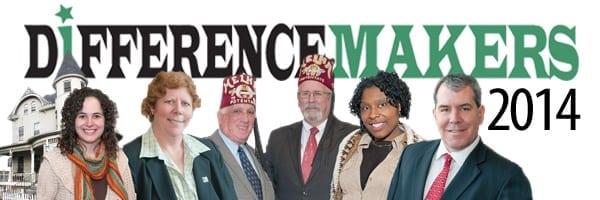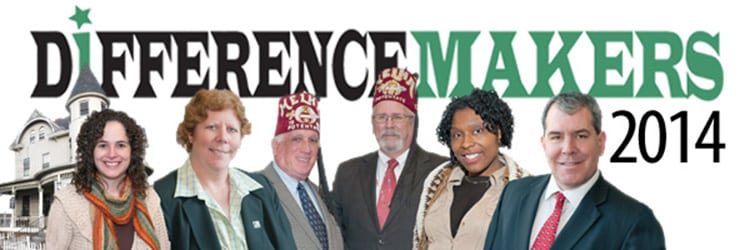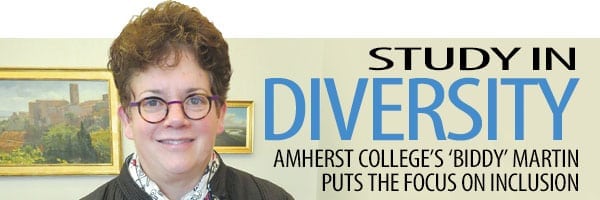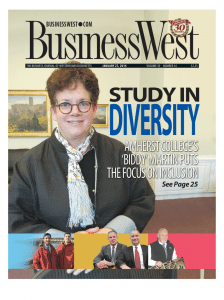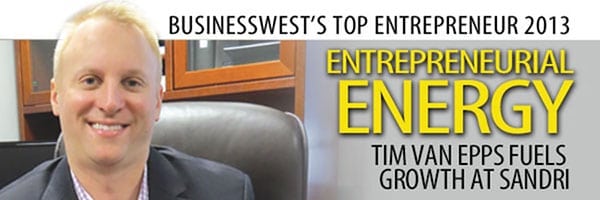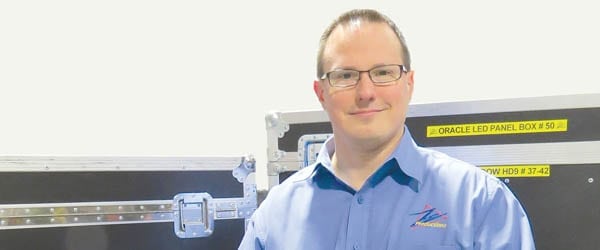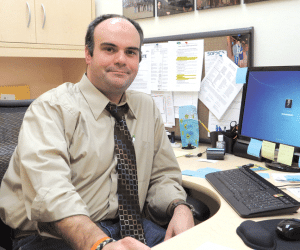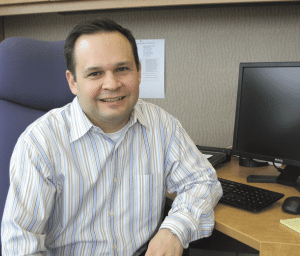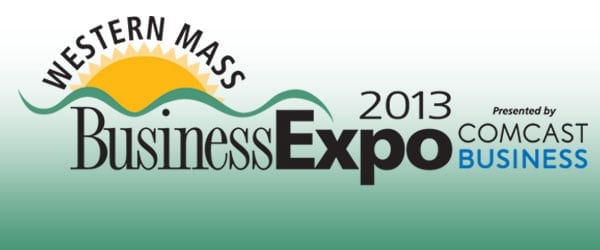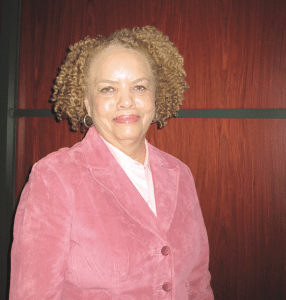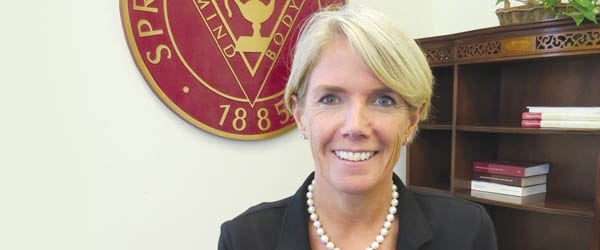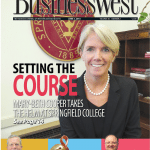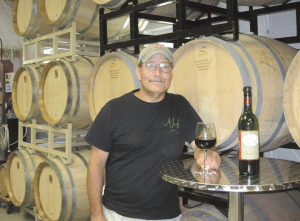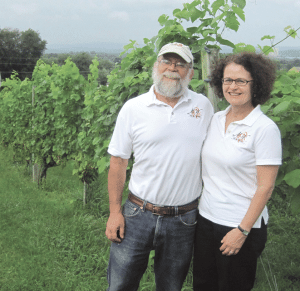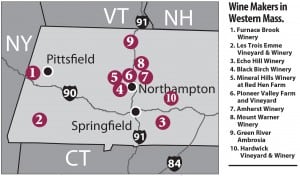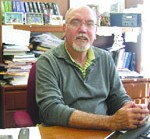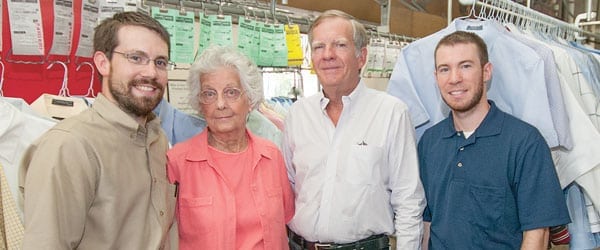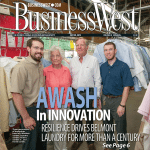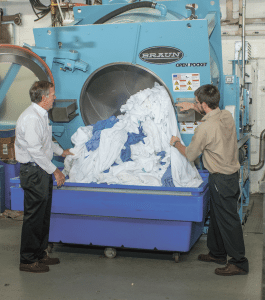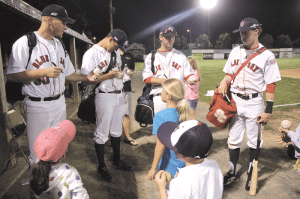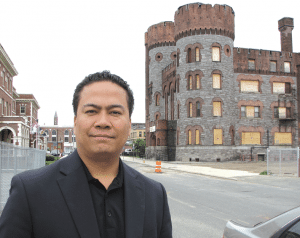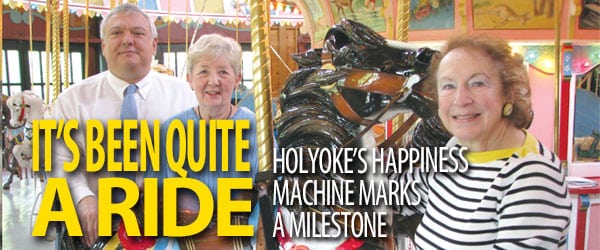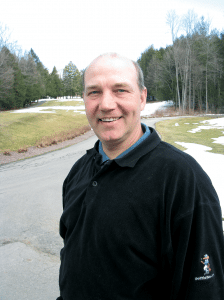Fueling the Imagination: Pride Founder Bob Bolduc Stays Ahead of the Curve

Bob Bolduc, Top Entrepreneur for 2010
Bob Bolduc said the concept came to him early last fall as he was pondering ways to say thank you to his ‘friends,’ a word he would use interchangeably with ‘customers’ early and often.
For years, Pride has offered free coffee on Christmas, New Year’s, and Veterans Day (Bolduc was in the Army and has a deep appreciation for all those who have served their country), but he thought it was time to take things up a notch — or several, as the case may be.
“Free coffee for the month of December,” he said slowly, as if to add emphasis and convey the enormity of this executive decision.
“A lot of people here looked at me funny, and some thought I was out of my mind,” he admitted while explaining the promotion that would involve the chain’s 24 stores, scattered across Western Mass. “That’s because we’re in the coffee business; it’s one of the things we do best, and it’s quite profitable.
“I can’t say how much it has cost us, but it’s expensive, very expensive,” he continued. “It’s worth it, though; it’s been fun, and it’s certainly created a buzz. This is a big cup we’re giving away — 16 ounces — not some dinky thing.”
With 10 days left in December, Bolduc could easily do the math concerning his coffee giveaway, and he was already declaring it a good business decision. And he should know, as he’s made quite a number of them in an entrepreneurial career that now spans nearly 40 years.
“There have certainly been some that haven’t worked out well,” he conceded with a hearty laugh, one of many that would punctuate his candid interview with BusinessWest. “But many have gone right for us over the years.”
Indeed, starting with his decision to get into the wholesale tire business in the early ’70s — and then out of it when the radial changed the landscape of that business by adding tens of thousands of miles to a tire’s lifespan — Bolduc has penned a number of success stories. And he’s made several of what he called ‘firsts,’ listing everything from the first fire-suppression system at a self-serve gas station to the first in-house Dunkin’ Donuts in this market; from cash acceptors at the fuel pumps to the first ethanol sold in Western Mass.
This body of work, as well as the indication that there’s plenty more to come, has earned Bolduc BusinessWest’s Top Entrepreneur Award for 2010.
“Bob Bolduc exemplifies what entrepreneurship — and this award — are all about,” said BusinessWest publisher John Gormally. “His career, most notably his work with Pride, has been characterized by risk-taking, having the vision to see the future of his industry, and getting there first in many cases, and simply being innovative; in many ways, he’s redefined the convenience store.
“We created this award to honor people who have those qualities — vision, innovation, and risk-taking,” he continued, “and he’s a very worthy recipient.”
Russell Denver, president of the Affiliated Chambers of Commerce of Greater Springfield, agreed, and praised Bolduc for his career accomplishments, as well as his recent aggressive steps in the face of the worst downturn in nearly 80 years.
“Here is a man who didn’t sit back during the last two or three years of difficult economic times,” he noted. “He charged forward and has dramatically redone most of his properties and built new properties. And he ended up increasing his employment levels in our communities.

Pride’s ‘free coffee for the month of December’ promotion, prominently displayed on the store at the North End Bridge, is one of many risks Bob Bolduc has taken during his career.
“What he has done to the troubled property that used to be Valley’s Steakhouse, and after that Razzles, has put a whole new face on Springfield as one enters from West Springfield,” Denver continued, referring to the latest Pride store just east of the North End Bridge. “Where there was a vacant building, an eyesore, is now a thriving business that employs about 70 people; it’s a stunning turnaround.”
And like most projects Bolduc has taken on since he first went into business for himself, the North End initiative involved a good deal of risk that he considers part and parcel to being a successful entrepreneur.
“If you don’t take risks … if you just play it safe, you’ll limit what you can do,” he said. “There are lots of risks and gambles in business; it’s not for the faint-hearted, and it never really stops.”
Pedal to the Mettle
BusinessWest sat down with Bolduc near the end of the work day (at least for most other people at Pride), a time he chose because the preceding hours were packed with more pressing matters.
The 90-minute conversation was interrupted, briefly, perhaps a dozen times by employees stopping by Bolduc’s office on the way out the door with questions, answers, updates, and agendas for the following day. When asked about what appeared to be micromanagement, Bolduc smiled and said, “show me a successful entrepreneur who is not involved in every aspect of his business.”
He then proceeded to say he’s better than he used to be when it comes to delegating responsibilities, but that he still considers even the smallest of details paramount to his operation and thus worthy of his time and attention.
“Every decision you make is important when you’re talking about your business,” he continued. “There are no small matters.”
This penchant for micromanagement is one of many aspects of Bolduc’s personality that come across loud and clear after only a few minutes of discussing business and society in general and watching him operate. Others include a real passion for what he does — this is a man who went on for five minutes about the quality of the breakfast sandwiches in his store and how proud he is of them — and both concern for and commitment to the city of Springfield (where he grew up), but also the broader subjects of education and parental involvement.
“Springfield has a serious education problem, there’s no question about that — 60% of kids drop out of high school, that’s a problem, and 60% of the fourth-graders can’t read to fourth-grade level,” he said. “That’s why we’re big supporters of early-childhood education and the early years, because it’s been proven that, if we don’t get kids started on the right track, and early, they will never make it.
“We need to get more people involved, and we need to convince some parents — I said some, not all — to get more involved in their children’s education, and make them do their homework, see that they get to bed on time and have a good breakfast, and inspire them to learn. On a bigger note, the whole country needs to do that; we need longer school days and longer school years, and we need to raise our standards — a lot — if we’re going to compete in the global economy.”
In many ways, the Pride chain and its various causes — from books to pajamas to toys — reflect Bolduc and his priorities, and it’s been that way since the beginning, or when he started down the path to entrepreneurship, which is the road he knew he would eventually take even as a mechanical engineering student at Notre Dame.
“I knew I wanted to be in business for myself some day,” he said. “I thought I had it in me, and my father and grandfather were both entrepreneurs.”
Born in Indian Orchard, Bolduc attended local public and parochial schools. After graduating from Notre Dame he went on to Purdue, where he earned an M.B.A. — and he’s put both degrees to good use. “I always enjoyed the engineering part as well as the business part.”
After graduate school, but before enlisting in the Army and eventually serving in Vietnam, he worked as a quality engineer at American Bosch. Upon returning from Southeast Asia in 1970, he briefly went to work at his father’s gas station in Indian Orchard before buying him out, thus becoming the third generation of the family to run that business.
In addition to running the station, he became a tire and auto-parts wholesaler, specifically a distributor for BF Goodrich and Continental, and became proficient enough at it to be chosen to address a national sales convention of Goodrich retailers at age 30.
As good as he was at tire wholesaling, Bolduc saw the handwriting on the wall with the introduction of the radial — and also foresaw changes that would cut out two layers of ‘middle’ people in this business — and thus sold off the venture. He then moved into an emerging field on the business landscape, one that he would ultimately help shape locally: the self-service gas station.
Priming the Pump
He started with one, again in Indian Orchard, in 1976, and continued to expand over the next 34 years, and counting.
In the process, he would not merely create a chain, but continually break ground when it came to the concept of marrying the self-service station with another emerging phenomenon, the convenience store.
Part of this matrimony was taking what was then a small store that sold bread, cigarettes, and dairy items (many people called them ‘milk stores’) and thinking outside that small box, he explained.
“We were the first chain in Western Mass. to put a Dunkin’ Donuts in our stores,” he went on, “and, later, we were the first to put a Subway in our stores — and then everybody copied both.
“We already had our own little deli shops, but when I saw the Subway concept, I said, ‘let’s give this a try,’” he continued. “And as for coffee and donuts, we were already making our own coffee, and buying a full line of products from the [former] Liberty Bakery. I sold cakes, donuts, everything; you could come in here and order a wedding cake from us, and people did.”
As he expanded the line of products and services inside the stores, Bolduc also expanded geographically, moving beyond his Springfield roots across the Pioneer Valley. “We expanded as we saw opportunities arise,” he explained, adding that many of his locations have been enlarged and renovated over the years to keep pace with his vision of what his stores should be offering.
“We’ve built and rebuilt our stores to keep up with the times and keep up with the changes we’ve made as a company,” he said. “I’ve rebuilt some stores four times as we’ve evolved from a full-service gas station to a gas-only self-service, to small stores, to large stores, and, now, to super-large stores that are able to pump fuel into as many as 20 vehicles at a time — cars and trucks.”
Bolduc said that, when many people think of the Pride name, they associate it with gasoline. He understands this — well, sort of, because this is how and why many trips to his locations begin or end. But he becomes somewhat animated as he stresses that his chain is about so much more than that.
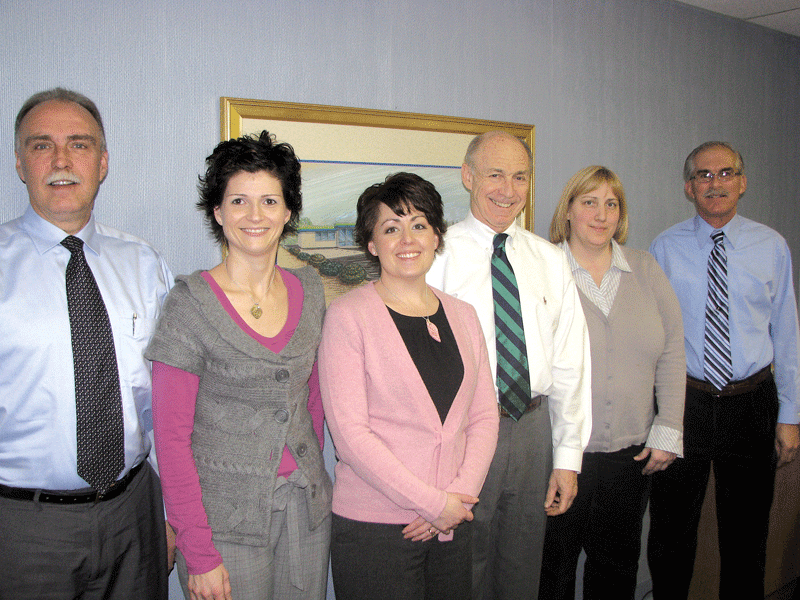
Bob Bolduc, center, with his senior management team
And to get his point across, he proceeded down the roster of what is now in the Pride inventory, for lack of a better term. This would be 24 stores; a commissary that makes baked goods, those aforementioned breakfast sandwiches, and a host of other items for those stores; 10 Subways, making Pride the largest franchisee in the region; six Dunkin’ Donuts locations (those spaces are leased out to the corporation); two truck stops; one package store; two beer-and-wine stores; a trucking company; a construction company; and a commercial fueling station for local fleets.
Today, in addition to Dunkin’ Donuts and Subway locations, the larger Pride stores are, in essence, full markets complete, in some cases, with shopping carts, and, in all locations, prices he says can compete with supermarkets.
Indeed, beyond the sheer volume of locations is what’s in the stores, Bolduc told BusinessWest, that should compel people to think of this as more than just a chain of gas stations.
“We’re in the milk business,” he said, again with a large dose of pride in accomplishment. “We’re a dairy store; we sell milk $1 or $1.50 less per gallon than the supermarkets. And it’s so fresh, because we’re turning it over every day.
“In some of the stores, we changed the name to Pride Market,” he continued, going on, in great detail, as always, about what his locations now offer. “We now have major food areas with all kinds of coffee, hot and iced, and our own brand of sandwiches, subs, and bakery items — fresh-baked cookies and muffins every day.”
This emphasis on price and variety is just one way Bolduc says he’s trying to take the perceptions about convenience stores — especially the one about how people have to trade this convenience for higher prices — and turn them on their ear.
“People from several generations wouldn’t think to buy in a convenience store because the price was too high,” he said. “You buy here, and you can save money.”
What’s in Store?
When asked if he and others at Pride spend much time studying consumers as they go about designing, stocking, and staffing Pride stores, Bolduc shrugged his shoulders slightly as if to indicate ‘not really.’
He said much of the success that he or anyone else enjoys in retail comes from instinctively anticipating what his customers or ‘friends’ want — like free coffee for the month of December — and then providing it in an efficient and cost-effective manner.
This thought process has taken him from simply putting Subway franchises in his stores to adding full delis and his own baked goods, as he described.
It also led him to the cash acceptors, which, it would seem to some, but not Bolduc, would work against the larger overall mission to get people into his stores.
“This saves someone the trouble of coming into the store and standing in a line to pay someone for the gas,” he said. “If someone was going to come in, they would come in anyway; this is a great convenience for people, and it’s worked out very well.”
And it also represents one of the many risks Pride and especially Bolduc have embarked on over the years. He said his goal has always been to make these risks calculated, and to manage the many gambles he’s taken, while also working to continually move his operation forward and to new heights.
And he says this is always a difficult task, no matter how much practice one has at it.
“In this business, you have to be a high-risk taker, and you need to have a very strong stomach at times,” he explained. “You don’t get to build a chain of our size with the real estate we have without taking some gambles and putting serious money on the table.
“And then, of course, you have to make it work,” he continued. “And the same goes for other decisions you make; when you’re an independent operation like ours, there’s no fallback — if you make a mistake, there’s no one to catch you.”
As an example of this risk-taking, Bolduc sited the North End location in Springfield, the biggest in the chain. It’s known to many long-time, or very-long-time, residents as the Valley’s Steakhouse site, even though that restaurant has been closed for decades. Bolduc expressed hope that it will someday be known as the ‘Pride site.’
He said he acquired the property a decade or so ago, sensing there would be an opportunity, but going on with the intent of being patient until he knew the time was right.
“I wanted to be sure I could build and operate the kind of facility the site deserved,” he explained. “So I took my time developing it.”
Eventually, two years ago, just as the Great Recession was getting started, he decided to move ahead. Why then, when most business owners were hunkering down?
“I just decided that it was the right time,” he said. “How did I know … I can’t tell you that.”
Today, Bolduc, along with a young leadership team (comprised mostly of women), is mulling the next gambles and the next steps in the evolutionary process for the chain and the genre. And while Bolduc did indeed use the word ‘I’ quite a bit in his talk with BusinessWest, he stressed repeatedly that what he’s accomplished in 34 years has been a team effort.
“I’ve hired a lot of great people along the way,” he said. “I owe it all to them and couldn’t have accomplished all this without them.”
And, often in concert with that team, he continues to get involved in the Greater Springfield community and especially the City of Homes, with support for everything from Springfield School Volunteers to Square One to the Springfield Falcons.
He said that, like many who grew up in the city and have watched it struggle in recent years, he’s eager for a turnaround and doesn’t believe it’s far off. And, like many, he said part of the problem is a lack of self-confidence and a preoccupation with all things negative.
“Yes, we have problems; all cities do,” he said. “We need to work on those problems, especially those involving our schools, but all we hear, unfortunately, is the negative.”
The Bottom Line
Bolduc was non-committal when asked if he would be repeating his free-coffee promotion through December later this year.
As with many other aspects of his business, he knows, or probably knows, the answer to the question, but isn’t exactly eager to share it.
What he does know, and can share, but in a very vague way, is that he is going to continue to develop ‘firsts,’ and strive to remain at the forefront of the ongoing evolution of the convenience store/self-service gas station.
He’s not sure how many times he’ll have to tear down and rebuild or find new, often-innovative ways to assemble sites and create locations. But he’s quite sure he’s not done taking risks — “because that’s what being an entrepreneur is all about.”
George O’Brien can be reached at [email protected]




